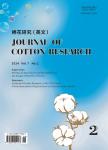In-depth analysis of Bt cotton adoption:farmers' opinions, genetic landscape, and varied perspectives——a case study from Pakistan
作者机构:Genetically Modified Organisms Development and Testing Laboratory Agricultural Biotechnology Research Institute Ayub Agricultural Research Institute Centre of Excellence for Olive Research and Trainings(CEFORT) Barani Agricultural Research Institute
出 版 物:《Journal of Cotton Research》 (棉花研究(英文))
年 卷 期:2024年第03期
页 面:277-288页
学科分类:120301[管理学-农业经济管理] 12[管理学] 1203[管理学-农林经济管理] 09[农学] 0901[农学-作物学]
基 金:supported by Punjab Agriculture Research Board, Grant numbers PARB No. 890 received research support from Punjab Agriculture Board
摘 要:Background Bt technology has played significant role in controlling bollworms and increasing cotton yield in earlier days of its introduction, a subsequent decline in yield became apparent over time. This decline may be attributed to various environmental factors, pest dynamics, or combination of both. Therefore, the present biophysical survey and questionnaire were designed to evaluate the impact of Bt cotton on bollworms management and its effect on reducing spray costs, targeting farmers with varied landholdings and educational backgrounds. Additionally, data on farmers cultivated varieties and the prevalence of bollworms and sucking insects in their fields were recorded. Subsequently, about eleven thousand cotton samples from farmer fields were tested for Cry1Ac, Cry2Ab and Vip3A genes by strip *** In this analysis, 83% of the farmers planting approved varieties believe that Bt technology control bollworms, while 17% hold contradictory views. Similarly, among farmers cultivating unapproved varieties, 77% agree on effectiveness of Bt technology against bollworms, while 23% disagree. On the other hand, 67% of farmers planting approved varieties believe that Bt technology does not reduce spray costs, while 33% agree with the effectiveness. Similarly, 78% of farmers cultivating unapproved varieties express doubt regarding its role to reduce spray costs, while 22% are in favour of this notion. Differences in opinions on the effectiveness of Bt cotton in controlling bollworms and reducing spray cost between farmers planting unapproved and approved varieties may stem from several factors. One major cause is the heavy infestation of sucking insects, which is probably due to the narrow genetic variation of the cultivated varieties. Additionally, the widespread cultivation of unapproved varieties(21.67%) is also an important factor to cause different opinions on the effectiveness of Bt *** Based on our findings, we propose that the ineffective cont



